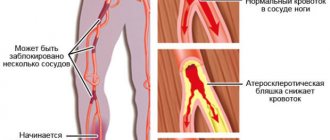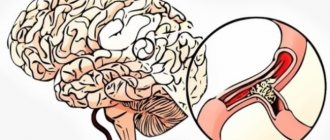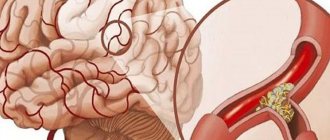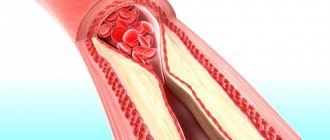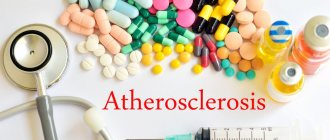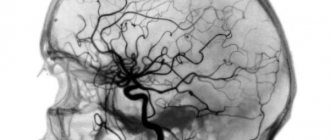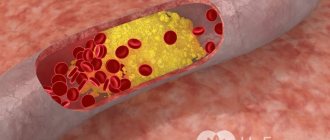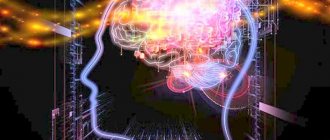Author's rating
Author of the article
Shoshina Vera Nikolaevna
Therapist, education: Northern Medical University. Work experience 10 years.
Articles written
218
Atherosclerosis of cerebral vessels is by no means a death sentence. Modern medicine has made great strides forward and offers patients effective therapies and drugs that can defeat this insidious disease. The main thing is that treatment is started in a timely manner, otherwise complications may arise due to damage to the arteries.
Modern medicine uses various medications to maintain the blood vessels of the brain in a healthy state. In the case of the formation of cholesterol plaques, they help relieve spasms, eliminate pain, reduce tumors, and prevent thrombosis.
What drugs for the treatment of cerebral atherosclerosis are the most effective and are actively used in medical practice?
Main vessels of the neck: location and functions
In humans, there are two main types of main arteries of the neck - carotid and vertebral (vertebral).
Both are paired. The right one arises from the brachiocephalic trunk, the left one from the aortic arch. Further, at the level of the upper edge of the thyroid cartilage, they are divided into the external and internal carotid arteries (ECA and ICA, respectively). The common carotid artery supplies blood to the scalp, tongue, pharyngeal muscles, the internal artery supplies the organ of vision, the cerebral hemispheres and the diencephalon (thalamus and hypothalamus).
The vertebral arteries depart from the subclavian and through the openings in the vertebrae of the cervical spine are directed to the brain, where they form the so-called vertebrobasilar basin, which supplies blood to the spinal and medulla oblongata, as well as the cerebellum. The ICA and vertebral arteries, as the main sources of nutrition to the brain, are combined under the name “brachiocephalic” or “extracranial”.
The main problem is atherosclerosis of the internal carotid arteries.
Atherosclerosis of the carotid arteries
The pathology is a chronic vascular disease in which cholesterol is deposited in the wall of the carotid arteries. Over time, plaques form, narrowing their lumen and disrupting the hemodynamics of the brain. In the international classification of diseases, this pathology is coded I65.2 . The risk of ischemic stroke (death of a part of the brain due to cessation or obstruction of blood flow) when the lumen of the ICA is narrowed by more than 50% increases 3 times.
Atherosclerosis of the ICA is responsible for approximately 20% of ischemic strokes.
Atherosclerosis of the carotid arteries is part of the structure of the so-called cerebrovascular disease, which, along with myocardial infarction and stroke, occupies a leading position among the causes of death. Its prevalence is approximately 6,000 cases per 100,000 population. It is especially common in older people.
Prevention of cerebral atherosclerosis
It is necessary to take the prevention of the development of atherosclerosis in the arteries of the brain seriously and change your usual lifestyle, because limiting yourself to an anti-cholesterol diet alone will not work.
If you do not change your lifestyle, the diet will not have a therapeutic effect. Prevention must begin with the following measures:
- Get rid of bad habits - alcohol and smoking;
- Change a sedentary lifestyle to actively playing sports, or increase the load on the body;
- Choose the right diet - exclude animal products and introduce more vegetables and grains into the diet, and also stop eating sugar, which is a good prevention of cerebral atherosclerosis;
- Get rid of extra pounds in the body. With obesity, proper nutrition will help, as well as stress on the body and activity.
Active sports activities
Non-drug treatment
Non-drug therapy consists of organizing an active lifestyle - you can take walks in the evening, and cycling will fill the brain cells with oxygen and prevent the development of hypoxia of brain tissue.
To treat atherosclerosis, it is necessary to give up bad habits, because if you abuse alcohol and cigarettes, any treatment will not bring results.
And one of the important methods of both therapy of atherosclerosis and its prevention is a diet with a low cholesterol content in foods.
Features in dietary nutrition
The diet should be dominated by products of plant origin and the correct eating regimen. Take food 6 times a day in small portions.
Vegetables, herbs and fruits should predominate in the diet (up to 60.0% of the total daily food volume), and the diet should also focus on sea fish and cereal porridges. Fermented milk foods can help restore lipid metabolism in the body.
Correctly selected nutrition is 50.0% of success during drug treatment and 100.0% of success during the period of prevention of pathologies of vascular diseases of the brain.
Vegetables, herbs and fruits should predominate in the diet
Causes and mechanism of disease development
Atherosclerosis of the carotid arteries develops due to many reasons. We list them in order of importance:
- Dyslipidemia. It is a disorder of lipid metabolism, namely the appearance of high levels of total cholesterol, low-density lipoproteins (“bad cholesterol”), as well as low levels of high-density lipoproteins (“good cholesterol”). Hereditary hypercholesterolemia sometimes occurs.
- High blood pressure. Constantly elevated blood pressure increases the risk of complications of any heart and vascular diseases.
- Diabetes. It has long been known that prolonged high concentrations of glucose in the blood accelerate the development of atherosclerosis several times.
- Obesity. Overweight people have much higher levels of cholesterol and triglycerides in their blood than those who are of normal weight. You can determine your body mass index here.
- Sedentary lifestyle – insufficient physical activity naturally leads to obesity.
- Smoking – components of tobacco smoke, including nicotine, contribute to the formation of free radicals (reactive oxygen species) in the body, which trigger lipid peroxidation. This cholesterol is deposited in the walls of blood vessels.
- Poor nutrition. Too much meat and not enough vegetables, fruits and fish lead to metabolic syndrome, which increases the risk of fatal heart conditions.
- Stress leads to increased blood pressure and the release of hormones that increase blood glucose.
- Genetic predisposition.
- Male gender. In men, atherosclerosis develops earlier and faster, because female sex hormones (estrogens) can slow down the process of plaque formation.
The mechanism of atherosclerotic plaque formation itself is quite complex and not fully understood.
It is worth noting that any person has cholesterol deposits on large vessels; even in stillborn children, at autopsy, minimal atherosclerotic changes in the walls of the aorta are found.
At this point in time, scientists distinguish three main stages of atherosclerosis:
- Formation of lipid spots and streaks. The first link is damage to the endothelium (inner lining) of the artery, which creates favorable conditions for the penetration of cholesterol particles. High blood pressure contributes most strongly to this. Macrophages absorb lipoprotein molecules, turning into foam cells.
- The appearance of a fibrous plaque. Further, due to damage to the endothelium and the accumulation of foam cells, growth factors are released, which leads to increased division of smooth muscle cells and the production of connective tissue fibers (collagen and elastin). A stable plaque is formed with a thick and dense fibrous cap and a soft lipid core, narrowing the lumen of the vessel.
- Formation of a complicated plaque. Progression of the process leads to an increase in the lipid core, gradual thinning of the fibrous capsule, rupture and parietal thrombus formation, almost or completely blocking the lumen of the artery.
In the case of the internal carotid artery, the parietal thrombus breaks off and occludes smaller vessels (middle, anterior cerebral arteries), causing an ischemic stroke.
Causes of the disease
Experts have identified many causes of cerebral atherosclerosis, which in most cases are combined with each other. The main and most common phenomenon that leads to the deposition of cholesterol plaques in the blood vessels of the brain is age. After 50 years, this disease occurs to one degree or another in 8 out of 10 people. The reasons for this are not fully understood, but scientists are inclined to believe that the body’s inability to remove harmful lipids from the body is caused by a natural slowdown in metabolism and changes in hormonal levels.
In addition, the risk of atherosclerosis at a young age can be affected by:
- unbalanced diet with a predominance of fatty, fried foods rich in carbohydrates and fats, hot spices in the menu against the background of an insufficient amount of fresh vegetables and fruits;
- irregular eating, when periods of acute hunger alternate with eating excessive amounts of food;
- diseases associated with metabolic disorders - diabetes, obesity, hypo- and hyperthyroidism and others;
- physical inactivity or lack of physical activity and resulting obesity;
- bad habits - smoking and alcoholism, which provoke vasoconstriction and affect the circulatory system as a whole.
Doctors do not rule out the influence of a genetic factor. According to statistics, 9 out of 10 people suffering from cerebral atherosclerosis have immediate relatives who also encountered diseases caused by the deposition of cholesterol in the circulatory system.
Since atherosclerosis very often occurs against the background of hypertension, experts classify this disease as a provoking one. Since stress is the main cause of high blood pressure, it is also considered indirectly involved in the occurrence of pathology. Under the influence of psycho-emotional factors, blood vessels can change their tone several times during the day (contract and relax), as a result of which microdamages form on their inner surface. On such wounds, cholesterol settles quite quickly, forming plaques.
Despite identifying the main sources of the disease, doctors cannot identify the main cause of cerebral atherosclerosis. They call this disease polyetiological, that is, developing as a result of a combination of several factors.
Favorite spots for plaques
Most often, atherosclerotic plaques are located in the following places:
- in the area of the bifurcation of the carotid artery, i.e., where the common carotid is divided into external and internal;
- at the mouth of the ICA – the initial segment of its branch from the ECA;
- at the mouth of the vertebral arteries;
- in the ICA siphon (the place of bend at its entry into the skull).
This is explained by the fact that in these places, due to the unevenness of the vessel, a turbulent (vortex) blood flow is created, which increases the likelihood of endothelial damage.
Prevention with folk remedies
Various folk recipes (herbs) are used as excellent preventive measures that will help restore the elasticity of blood vessels, remove harmful cholesterol, and cleanse the arteries.
Garlic infusion
- Grind about 300 grams of garlic.
- Take 200 grams of the resulting mass without juice and pour 96% alcohol in equal proportions.
- Cover the container with a lid and let the mixture brew for 10 days.
Rosehip tincture
- The rosehips are crushed and poured into a half-liter jar (it should be 2/3 full).
- Then they are filled with vodka.
- Infuse in a dark place for 2 weeks; it is important to shake the infusion every day.
Plantain infusion
Washed leaves (1 tablespoon) are crushed.- Pour 1 tbsp. boiling water
- Leave for about 15 minutes.
Symptoms and complaints of the patient
Clinical symptoms of cervical atherosclerosis occur when the lumen of the artery is narrowed by more than 50%, and the brain begins to experience oxygen starvation. As practice shows, there are patients with a greater degree of stenosis who do not show any complaints and feel completely healthy. Long-term insufficiency of blood supply to the brain is called chronic ischemia or discirculatory encephalopathy . Its symptoms:
- rapid onset of fatigue, decreased physical and intellectual performance;
- memory impairment and mental degradation;
- loss of critical thinking;
- frequent mood swings;
- sleep disturbance – drowsiness during the day, insomnia at night;
- dizziness, headache, tinnitus.
The insidiousness of atherosclerosis is that for a long time it can be completely asymptomatic until the development of acute conditions. These include:
- transient ischemic attack;
- ischemic stroke (ICH).
A transient ischemic attack (TIA) is a sudden deterioration in blood circulation in a certain area of the brain. It is a pre-stroke condition. Symptoms:
- dizziness;
- imbalance, unsteadiness of gait;
- transient blindness in 1 eye;
- speech disorder;
- numbness, feeling of weakness in one half of the face, arm, leg, etc.
With an ischemic stroke, almost the same picture is observed, but more severe, with a risk of death; complete paralysis of one half of the body or an epileptic seizure may also occur. The main difference between TIA and stroke is that its symptoms completely disappear after 24 hours, and in the case of stroke they remain for a long time and also require specialized measures. If a TIA is not diagnosed in time and not provided with qualified treatment, it can turn into a stroke.
The most effective drugs
The effectiveness of the drug depends on the correct determination of the indications. If the patient urgently needs to normalize lipid metabolism, the doctor will prescribe lipid-lowering drugs; if it is necessary to lower blood pressure, antihypertensive drugs, etc.
Therefore, the patient should never self-medicate. After all, in order to determine which particular remedy will be most effective, the doctor conducts diagnostic tests, collects anamnesis, and only then prescribes the drug.
Modern pharmacology is rich in the choice of agents that inhibit cerebral atherosclerosis. The main thing is to choose the right medicine that will satisfy all the indication criteria.
Rosuvastin
These tablets for atherosclerosis are available in dosages from 5 to 40 mg. The advantage of this drug is that it can be taken in lower dosages than conventional statins. The drug effectively reduces low-density lipoproteins (bad cholesterol).
Rosuvastatin is prescribed in small dosages, then the doctor increases them. Sometimes short-term therapy with a high dose (40 mg) is necessary. It is carried out under the close supervision of a doctor. Further, the dosage is reduced with subsequent discontinuation of the drug.
The general course is about three weeks.
This drug is mainly prescribed to middle-aged and elderly people.
The use of this remedy is strictly contraindicated:
- Pregnant and lactating women;
- Patients with reduced kidney and liver function;
- People suffering from alcoholism.
It is prescribed with caution to patients with problems with the thyroid gland.
The price in pharmacies ranges from 250 to 1300 rubles, depending on the manufacturer and dosage.
Atorvastatin
The effect of the drug is to reduce low-density lipoproteins by increasing high-density lipoproteins. Dosage form – tablets, dosage – 20, 30, 40 mg.
This remedy is indicated for patients with metabolic disorders during age-related changes.
The drug is contraindicated:
- People with thyroid pathologies;
- Pregnant;
- During lactation;
- For alcoholism;
- With kidney and liver pathologies;
- With low blood pressure.
This drug should be prescribed with caution to patients who have recently undergone surgery, various types of trauma, or infectious diseases.
Therapy begins with a low dose of 10 mg, gradually increasing it (possibly up to 80 mg). The course of treatment is three to four weeks.
The price of the drug ranges from 120 to 750 rubles. The higher the dosage of the drug, the correspondingly higher the price.
Simvastatin
A drug with the same active ingredient. Its main effect is aimed at blocking certain enzymes that produce cholesterol, or more precisely, its atherogenic fractions - low-density lipoproteins and triglycerides.
Release form: tablets, in dosages from 10 to 40 mg. Taking less than ten milligrams of this drug is considered ineffective. The maximum dose should not exceed 80 mg, as this is dangerous for the body.
Like all statins, this drug is contraindicated in pregnant and lactating women, patients with liver and kidney pathologies, and alcoholics.
In addition to general contraindications, lactose intolerance is also indicated. The course of treatment depends on the indications and dynamics of improvement, but on average it is three to four weeks.
The average cost of this medicine ranges from 70 to 370 rubles, depending on the manufacturer and dosage.
Fenofibrate
The action of this drug is aimed at reducing low-density lipoproteins by activating enzymes that consume triglycerides for digestive processes.
The permissible daily dose of this medicine is from 140 mg to 400 mg.
Fenofibrate is contraindicated:
- Patients with reduced liver or kidney function;
- People with gallbladder pathologies;
- Pregnant and lactating women;
- Elderly;
- Children and teenagers.
The pharmacological market offers several types of this drug, which differ from each other in packaging, manufacturer and some elements of the composition.
The most popular drugs are the following, the active substance of which is fenofibrate. Namely:
- Lipantil, in a dosage of 200 mg - capsules (30 pieces per package), cost in pharmacies - about 900-1000 rubles;
- Traykor (145 mg), release form - tablets (30 pieces) at a price of 800 rubles;
- Fenofibrate-canon (145 mg) - tablets (30 pieces), price in pharmacies - about 700 rubles.
Treatment with these types of drugs is carried out over several months.
The discontinuation of drugs, as well as their prescription, is carried out by the attending physician. You should not take or stop medications on your own, as this can cause serious harm to your health.
Aspirin
Acetylsalicylic acid in modern pharmacology has several forms of release. The active ingredient is aspirin, to which a certain amount of useful substances is added. This varies the price of the medicine.
The most popular drugs whose active ingredient is aspirin are:
- Polocard;
- Aspercard;
- Lospirin;
- Aspirin-cardio.
Acetylsalicylic acid is always prescribed for atherosclerotic vascular lesions. This happens because this drug has a fast-acting blood thinning effect. By taking it as prescribed, patients with atherosclerosis significantly reduce the risk of blood clots.
Aspirin is contraindicated:
- Patients with bronchial asthma.
It is prescribed with caution to people with diseases of the stomach or duodenum, as it has an irritating effect on the mucous membrane.
Clopidogrel
This drug belongs to the group of antiplatelet agents. Antiplatelet drugs basically have an effect that prevents platelet aggregation. When taken, the blood acquires normal fluidity, and this prevents thrombus formation.
This drug does not have such a quick effect as aspirin; its effect lasts longer.
Taking 100 mg of it, you can observe the maximum concentration of the drug on the seventh day. The effect of its influence lasts for ten days.
Contraindications for the drug are the same as for the general group of antiplatelet agents:
- Hemorrhagic diathesis;
- Individual intolerance;
- Kidney failure;
- Breast-feeding;
- Pregnancy;
- High risk of bleeding;
- Decreased liver function;
- Neurotropenia;
- Acute coronary syndrome.
In addition to the general factors listed, this drug is also not recommended for use by people whose work involves increased concentration.
The price in pharmacies ranges from 130 rubles per blister containing ten tablets. You can also purchase a package containing 90 tablets for a thousand rubles.
Dipyridamole
Another effective antiplatelet agent is dipyridamole. Among the contraindications, those common to all antiplatelet agents are indicated, and attention is also drawn to the fact that simultaneous use of this medicine and aspirin is not recommended, since it will have a double effect that can provoke negative consequences.
It can also be detrimental to the mucous membrane of the stomach and duodenum.
Taking this medication in the first trimester of pregnancy is absolutely prohibited. Also, you should not use it during lactation (breastfeeding).
The approximate daily dose ranges from 75 mg to 170 mg, divided into several doses. The dosage and regimen of use of this drug, like any other medicine, is determined by the attending physician, since it depends on the indications and individual characteristics of the body.
The price in pharmacies varies, depending on the manufacturer, packaging and number of tablets. One package can contain from forty to one hundred tablets, packaged in blisters, each containing ten tablets.
Dipyridamole can be bought from 15 to 300 rubles.
The duration of treatment depends on many factors that the doctor takes into account when prescribing therapy. It can be either short-term or long-term.
A nicotinic acid
This is a B vitamin. Its required daily dose for the body is no more than twenty milligrams. And in order to have a hypolipidemic (lowering low-density lipoprotein) effect, you need from one thousand to six thousand milligrams of this drug.
It is precisely because the drug works only at high dosages that it is rarely prescribed. But sometimes it happens that the patient has intolerance to statins or fibrates, and therefore it is necessary to develop a different treatment strategy that uses nicotinic acid.
A high dosage can cause many undesirable effects, namely:
- General weakness;
- Dizziness;
- Headache;
- Stool disorders;
- Hoarseness;
- Edema;
- Nausea;
- Lack of appetite;
- Kidney and liver failure;
- Gout;
- Muscle pain;
- Increased blood sugar;
- Deterioration of vision, blindness;
- Bruises;
- Tachycardia.
Nicotinic acid is contraindicated:
- Children under two years old;
- Patients with type 2 diabetes mellitus;
- With glaucoma;
- Suffering from gout;
- With impaired blood clotting;
- Alcoholics;
- People with individual intolerance to the drug.
Nicotinic acid is prescribed as an additional remedy. The duration of use of nicotinic acid depends on the dynamics of treatment, but, as a rule, therapy is always long-term.
Often nicotinic acid is prescribed together with ascorbic acid.
The price in pharmacies ranges from 40 to 150 rubles.
Signs of atherosclerosis on ultrasound, Doppler and duplex
Ultrasound is a quick and easy way to assess the condition of the vessels. This is one of the first instrumental diagnostic methods that is prescribed to a patient if a diagnosis such as atherosclerosis of the carotid arteries is suspected.
There are 2 methods of ultrasound examination of blood vessels:
- dopplerography;
- duplex scanning.
With Doppler ultrasound, you can only see the speed of blood flow and determine whether it is disturbed. Duplex scanning allows you to evaluate the anatomy of the vessel, its tortuosity, wall thickness and plaques. To diagnose atherosclerosis of the carotid arteries, this type of study is prescribed, since it is more informative.
Diagnostics
In order to prescribe competent and effective treatment, it is necessary to correctly identify the disease and the degree of its development.
For this purpose, the specialist collects anamnesis (all the necessary information about the possible signs and causes of its formation). If possible unpleasant factors are detected, the doctor conducts a biochemical and clinical blood test. After this, an ultrasound duplex scan of the vessels of the cervical spine and brain is usually done.
This makes it possible to visualize the vessels and accurately determine their condition: structure, the presence of modifications on the walls, and the localization of cholesterol plaques (if they are detected). As a result, you can get a complete picture of the damage to the cervical vessels.
Treatment methods
Treatment of atherosclerosis of the carotid arteries is a complex task. The method of therapy directly depends on the degree of vascular stenosis and the clinical picture, namely the presence of dyscirculatory encephalopathy and previous transient ischemic attacks and strokes. With a slight narrowing of the ICA and minor symptoms, the absence of acute conditions, you can manage only with drug therapy:
- Statins (Atorvastatin, Rosuvastatin) are the main type of drugs that slow down the progression of atherosclerosis. They reduce the concentration of cholesterol in the blood. The target low-density lipoprotein level is less than 1.8 mmol/L.
- Acetylsalicylic acid prevents the formation of a blood clot on an atherosclerotic plaque. If the patient has a peptic ulcer of the stomach or duodenum, he is preferably prescribed Clopidogrel.
- Means for lowering blood pressure. The patient needs to maintain blood pressure numbers at a certain level (<140/90 mm Hg, and for diabetes <130/80 mm Hg). For patients with atherosclerosis, ACE inhibitors (Perindopril, Lisinopril), sartans (Losartan, Valsartan) or calcium antagonists (Amlodipine) are preferred from all pharmacological groups.
- Medicines for diabetes. To stabilize blood glucose levels, hypoglycemic agents (Metformin, Glibenclamide) or insulin injections are prescribed.
What surgical treatment methods are applicable for cervical atherosclerosis? There are 3 main indications for their use:
- stenosis more than 70% with absolutely asymptomatic course;
- stenosis more than 60% with dyscirculatory encephalopathy;
- stenosis more than 50% if there were acute conditions (TIA or ischemic stroke).
Even if a person decides to undergo surgical treatment of an atherosclerotic plaque in the carotid artery, he must still take the medications listed above.
There are the following methods of surgical intervention for atherosclerosis of the ICA, each of which has its own subtleties and nuances:
- carotid endarterectomy – classic and eversion;
- stenting.
With classic endarterectomy, the operation is performed under general anesthesia. After dissection of the skin and subcutaneous fatty tissue, the carotid artery is isolated in the bifurcation area. Then, to avoid massive bleeding, the CCA is clamped. A longitudinal incision is made into the ICA, and the atherosclerotic plaque is carefully separated from the intima with a spatula.
The hole is closed with a patch made from the large saphenous vein or synthetic material. Its installation is preferable to simple suturing, as it has a lower rate of restenosis. This method is used when the plaque length is more than 2 cm.
Eversion endraterectomy differs in that it does not involve a longitudinal incision of the ICA, but its complete separation from the CCA, gradual eversion and cleansing of the cholesterol plaque. The advantage of this method is less deformation and a reduced risk of arterial restenosis. However, it can only be used for small lesions (up to 1.5-2 cm).
The third method is endovascular stenting. This operation is performed under local anesthesia. A catheter with a balloon is inserted through a puncture in the femoral artery. Under fluoroscopic control, he reaches the site of narrowing in the carotid artery. The balloon is inflated, then a metal stent (wire cylinder) is installed using another catheter to hold the vessel in an expanded state. This operation is less traumatic, safer, and does not require general anesthesia. However, it is less effective compared to endarterectomy, especially with a severe degree of stenosis (more than 85%).
Modern approaches to treatment
Treatment for atherosclerosis of cerebral vessels is selected individually by a specialist. It should be comprehensive and include recommendations on lifestyle, nutrition, medications and sometimes even surgical methods.
Note! The treatment of cerebral atherosclerosis is carried out by a neurologist together with a therapist. In case of severe circulatory disorders, as well as concomitant metabolic diseases, consultation with an angiosurgeon, ophthalmologist, endocrinologist and other specialists may be required.
Focus on lifestyle
Lifestyle correction is the first thing that specialists usually recommend to patients with dyslipidemia.
If we recall the factors influencing the development of the disease, it becomes clear that many of them can and should be eliminated:
- Give up bad habits. Alcohol abuse and smoking in atherosclerosis of the arteries of the head aggravate the patient's condition due to an indirect increase in the level of cholesterol in the blood and a damaging effect on the vascular walls.
- Move more. This will “disperse” the blood in the body and reduce the risk of the formation of atherosclerotic deposits.
- Try to minimize stress in your life. Severe psycho-emotional experiences stimulate the production of the hormones cortisol and norepinephrine, which narrow the arteries and cause disruption of blood flow in the vessels of the brain.
- Take care of your health. Regularly undergo preventive medical examinations to diagnose metabolic disorders at an early stage.
Note! It is not recommended to perform strenuous physical exercises when you are ill: they can lead to acute cerebral catastrophe. It is important to discuss the degree and types of permitted load with your doctor individually.
Therapeutic gymnastics is also useful. It is designed to improve blood circulation in the arteries of the head and neck and prevent further formation of cholesterol plaques.
Exercise therapy reduces the risk of complications
Table 2: Sets of exercises for cerebral diseases:
| No. | Starting position (IP) | Execution technique | Number of repetitions |
| 1 | standing | Walking in place at a moderate pace | 2-3 minutes |
| 2 | Standing, feet together. Palms on the lower back, thumbs around the waist | Exhale - draw in your stomach as much as possible. Inhale - inflate your stomach. | 3-4 r. |
| 3 | Sitting on a chair with a straight back, arms bent at the elbows, palms in front of the chest | On the count of “1”, clench your hands into a fist. On “2” - relax your hands. On “3” - raise your hands up and shake. On “4” - accept IP. The pace of the exercise is slow. | 3-4 r. |
| 4 | Sitting, holding hands on the seat | Raise your legs 40-50 cm above the floor. At an average pace, perform rotational movements in the ankle joint, first in one direction, then in the other direction. After 15-20 seconds, return to the IP. | 5-6 times |
| 5 | Sitting on a chair | Alternately bend your arms and legs at large joints on the right and left sides, imitating walking. | 2-3 minutes |
| 6 | Standing at the back of a chair, legs together, hands on a support | On the count “1”, move your right leg to the side, turn your head to the right. On the count “2” - return to IP. Repeat the same on the other side. | 5-6 times |
| 7 | Same | On “1” - take your right leg as far back as possible, at the same time bend at the waist and slowly tilt your head back. Stay in this position for 2-3 seconds. On “2” - return to IP. | 5-6 times. |
Daily physical therapy for atherosclerosis will not only reduce the unpleasant symptoms of the disease, but will also help avoid such serious complications as TIA and stroke.
How to eat properly if you have cholesterol metabolism disorders
Diet for atherosclerosis of the vessels of the head is another mandatory method of treating the disease. Although most cholesterol is synthesized in liver cells, about 20% of this fat-like substance comes from food.
If a person does not follow a diet and often eats foods rich in animal fats, the balance of lipoproteins in the body can be disturbed, and “bad” cholesterol becomes much more than “good”.
Note! Some patients successfully use therapeutic fasting for vascular atherosclerosis, the rules of which were developed by Paul Bragg. However, long-term (more than three days) therapy is recommended to be carried out only in a hospital setting under round-the-clock medical supervision.
Medical nutrition should be based on the following principles:
- Eliminating foods rich in saturated fatty acids from the diet. These include fatty meat, lard, offal (liver, kidneys, brains), high-fat milk, cream, butter, hard cheeses.
- Regular consumption of foods containing polyunsaturated fatty acids, rich in “good” cholesterol. Useful products for pathologies of cerebral vessels - sea fish, nuts, high-quality olive oil, etc.
- Enough fiber in your daily diet. Seasonal vegetables and fruits will not only saturate the body with vitamins, but also improve digestion, stimulating the release of excess cholesterol naturally through the gastrointestinal tract.
- Compliance with drinking regime.
The highest amount of cholesterol is found in organ meats
Note! Microelements and vitamins for circulatory disorders in the central nervous system are also very important. You can get them in sufficient quantities by eating properly and nutritiously or by taking specialized biologically active food supplements.
Drug therapy methods
If within 2-3 months measures to correct lifestyle and diet are ineffective, drug treatment is required.
Most often, doctors prescribe the following tablets:
- statins (Atorvastatin, Simvastatin) – reduce the synthesis of “bad” cholesterol by liver hepatocytes;
- fibrates (Clofibrate, Fenofibrate) – increase the utilization of fat-like substances through the gastrointestinal tract;
- bile acid sequestrants (Colestipol, Cholesteramine) – bind bile acids and cholesterol in the intestine, actively remove them naturally;
- nicotinic acid - reduces cholesterol synthesis in the intestine and corrects the ratio between HDL and LDL.
Note! The therapeutic effect of drugs against cerebral atherosclerosis does not occur immediately, but 2-3 months after the start of treatment. Patients have to take the pills for a long time - from 6 months to several years.
Injections for cerebral atherosclerosis are usually not prescribed. Injectable forms of diuretic (decongestant), thrombolytic, and vascular drugs are used only for stroke, when you need to act quickly.
It is known that physiotherapy has a positive effect on patients: it helps restore impaired blood flow and reduces the severity of symptoms of the disease.
The most effective are:
- electrophoresis on the cervical-collar area;
- diadynamic currents;
- electrosleep (for insomnia).
Physiotherapeutic procedures must be prescribed by a doctor
When is surgery necessary?
In some cases, cerebral circulation is impaired so severely that surgical intervention becomes necessary. Surgery for cerebral atherosclerosis is performed for clinically and instrumentally confirmed indications (after stroke, with frequent TIAs, narrowing of the main arteries of the neck and head by more than 65%).
To restore blood flow:
- stenting - installation of a stent (a frame that prevents the collapse of the vascular wall in the future) inside a narrowed artery;
- shunting is the creation of alternative blood circulation routes through collaterals.
Stenting can achieve good results
Expert advice: lifestyle changes
In addition to drug and surgical treatment, lifestyle correction plays an important role. I always recommend that my patients stop smoking, exercise regularly, and make changes to their diet (eat more vegetables, fruits and fish). Patients with diabetes need to periodically donate blood for glycated hemoglobin, follow a low-carbohydrate diet, visit an endocrinologist and take prescribed medications to lower blood sugar.
Atherosclerotic lesions of other vessels of the neck: signs, diagnosis and treatment
Atherosclerosis of the vertebral arteries is less common and develops at a later age than the carotid arteries. However, it is responsible for 20% of ischemic strokes in the occipital region of the brain.
Clinical symptoms are as follows:
- vision problems - double vision, flashes, lightning, blurred or loss of visual fields;
- hearing loss, tinnitus;
- imbalance, body instability when walking or standing;
- dizziness, sometimes so severe that it causes nausea and vomiting.
A very characteristic sign of damage to the vertebral arteries are drop attacks. These are sudden falls without loss of consciousness that occur during sudden turns or throwing back the head. With severe stenosis, the acute conditions described above (TIA and stroke) may develop. Diagnosis is carried out using the same methods as for atherosclerosis of the carotid arteries - Doppler ultrasound and duplex scanning. CT angiography is sometimes used.
Drug therapy remains unchanged, but the indications for surgery are somewhat different.
If the patient does not have any symptoms of cerebrovascular accident, then surgery is not performed, even despite the severe degree of stenosis.
If clinical signs are present and stenosis is more than 50%, surgical intervention is performed. Preference is given to open endarterectomy, since endovascular stenting in such patients has shown very low effectiveness.
Treatment of cerebral atherosclerosis
There are several methods for treating vascular sclerosis:
- Treatment with medications;
- Surgical treatment of sclerosis of the cerebral arteries.
Drug treatment
To quickly free the brain vessels from the pathology of atherosclerosis, medications are prescribed:
- Medications of the statin group. The drugs used are Atorvastatin, Rosuvastatin, Simvastatin tablets;
- Treatment is with fibrates. The pharmacological properties of fibrates are to activate enzymes that enhance the utilization of cholesterol molecules and activate reductase receptors. The drug Fenofibrate is prescribed;
- Antiplatelet drugs. Prevents thrombosis of intracerebral vessels. The drug Aspirin is prescribed;
- Nootropic drugs. Improves the functionality of brain cells. The most used drug is Piracetam;
- Vasodilator drugs help treat atherosclerosis in the brain. The drug Actovegin is prescribed;
- Treatment uses antidepressants, sedatives and selected vitamin and mineral complexes.
Medications are prescribed to treat atherosclerosis
Surgical techniques for treating cerebral atherosclerosis
The following methods are used to treat cerebral atherosclerosis:
- Endarterectomy. Open surgery to remove atherosclerotic plaque. More often it is carried out on extracranial highways to ensure blood flow to the brain;
- Arterial stenting. Minimally invasive method of stent installation. It is used on extracranial and intracranial arteries.
Case study: atherosclerosis of the vertebral arteries
A 57-year-old man began to complain of slight dizziness and hearing loss.
Those close to him told him that his gait had become uneven. A week ago, when he suddenly turned his head, he lost his sense of balance and fell, after which the patient came to the doctor. Upon questioning, it turned out that he suffers from hypertension and type 2 diabetes. Takes prescribed medications irregularly. When measuring blood pressure, the tonometer showed a value of 165/95 mm Hg. Art. Suspecting atherosclerotic lesions of the vertebral arteries, I ordered a duplex scan, during which stenosis of the right VA up to 65% and narrowing of the left VA up to 40% were detected. I referred the patient for surgical treatment.
Endarterectomy of the right VA was performed. The patient was also prescribed drug therapy - Rosuvastatin, Acetylsalicylic acid, Perindopril, Metformin. The patient noted a significant improvement - the dizziness stopped and a sense of balance returned.
